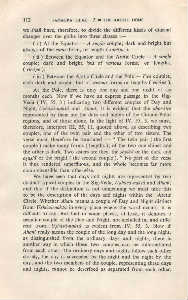Page 327 - Lokmanya Tilak Samagra (khand 2)
P. 327
112 SAMAGRA TlLAK - 2 • THE ARCTIC HOME
we shall have, therefore, to divide the different kinds of diurnal
changes over the globe into three classes :-
( i) At the Equator- A single couple; dark and bright but
always of the same form, or length ( sarupe ).
( ii ) Between the Equator and the Arctic Circle - A single
couple; dark and bright, but of various forms, or lengths,
( virupe ).
( iii ) Between the Arctic Circle and the Pole - Two couples,
each dark and bright; but of various forms or lengths ( virupe ).
At the Pole, there is only one day and one night of six
months each. Now if we have an express passage in the ~ig
Veda (IV, 55, 3) indicating two different couples of Day and
Night, U~hr1sa-naktd and A/zan£, jt is evident that the ahoratre
represented by them are the days and nights of the Circum-Polar
regions, and of those alone. In the light of IV, 55,. 3, we must,
therefore, interpret III, 55, 11, quoted above, as describing two
couples, one of the twin pair and the other of two sisters. The
verse must, therefore be translated :- " The twin pair ( the first
couple ) make many forms ( lengths ) ; of the two one shines and
the other is dark. Two sisters are they, the shyavi or the dark and
aru~hf o'r the bright (the second couple). " No part of the verse
is thus rendered superfluous, and the whole becomes far more
comprehensible than otherwise.
We have seen that days and nights are represented by two
distinct typical couples in the ~ig-Veda, U~hasd-naktd and Ahani;
and that if the distinction is not unmeaning we must take this
to be the description of the days and nights within the Arctic
Circle. Whether Ahani means a couple of Day and Night distinct
from U~hd,sa-naktd in every place where the word occurs, it is
difficult to say. But that in some places, at least, it denotes a
peculiar couple of the Day and Night, not included in, and diffe-
rent from, U~hdsa-nakta is evident from IV, 55, 3. Now if
Ahan£ really means the couple of the long day and the long night,
as distinguished from the ordinary days and nights, there is
another way in which these two couples can be differentiated
from each other. The ordinary days and nights follow each other
closely, the day is succeeded by the night and the night by the
day; and the two members of the couple, representing these days
and nights, cannot be described as separated from each other.

